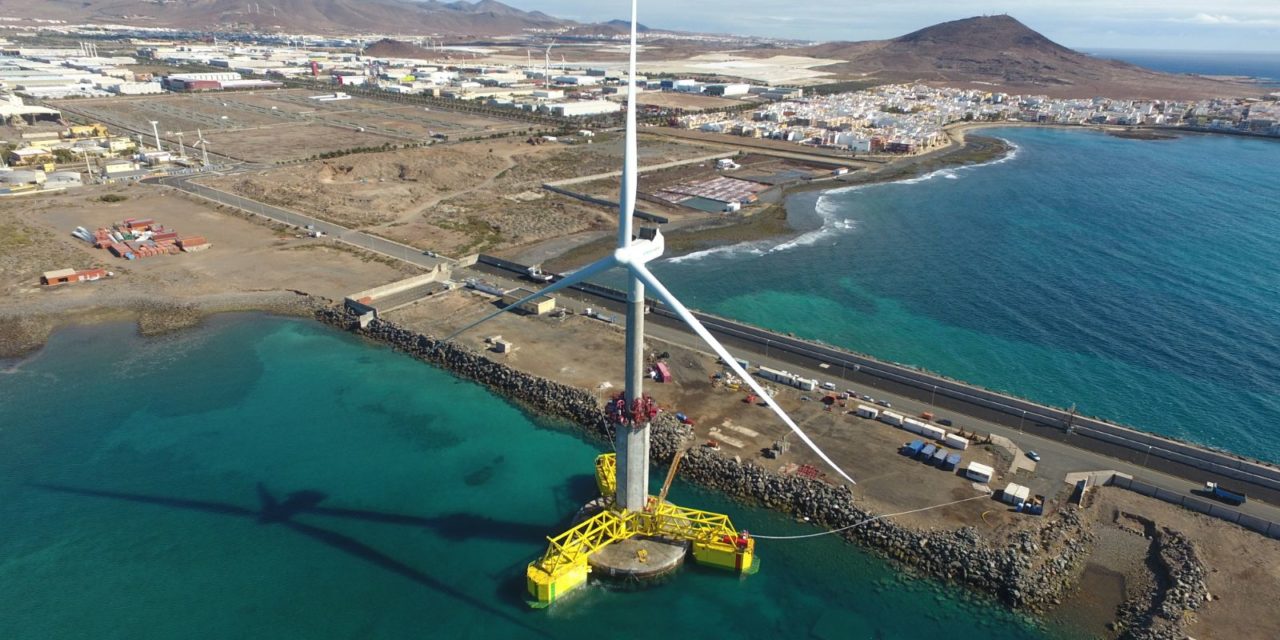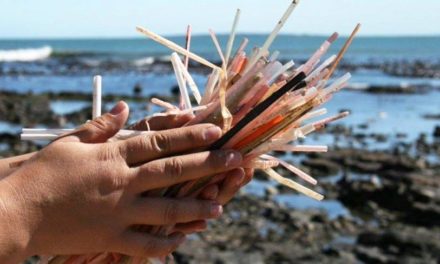 It travelled through the night at just over one knot, begins the unassuming report in Spanish language daily La Provincia, and by 6.50 am on Thursday morning, even before dawn, it reached its final destination at the PLOCAN Canary Islands Oceanic Platform, in the Jinámar bay at the southern entry point to Las Palmas de Gran Canaria, beside the GC-1 main motorway.
It travelled through the night at just over one knot, begins the unassuming report in Spanish language daily La Provincia, and by 6.50 am on Thursday morning, even before dawn, it reached its final destination at the PLOCAN Canary Islands Oceanic Platform, in the Jinámar bay at the southern entry point to Las Palmas de Gran Canaria, beside the GC-1 main motorway.
One more iconic structure heralding the capital’s imminence, this time an experimental wind turbine built in the Port of Arinaga, over the course of the last year, that once again places Gran Canaria firmly on the global map for offshore wind energy: it is not only the first one in Spain, and indeed the first of its kind in Southern Europe with a fixed base, but it is also the very first one on the planet, to be installed with a fixed base without having to employ the usual large and expensive marine cranes that have become common in the sector. The culmination of a more than 10-year project, partly funding by the EU, to improve viability for what is sure to become a primary energy resource for these islands and elsewhere.
 “This might be a revolution not only in the Canary Islands and in Spain, but throughout the world” says general director of Esteyco, Carlos García Acón, the company that has led the pioneering project. The new wind turbine was escorted by three tugboats from the Boluda Corporación Marítima, a vessel from Sepcan, tugs and divers from Piélago Ingeniería y Medio Ambiente, the companies that were in charge of positioning the completed construction and carrying out the second phase of the installation, anchoring to the seabed below the structure on which the tower stands. “It’s a large base, a concrete footing 32 meters in diameter and seven meters high; It is hollow with six cells and we have sunk it by filling it with water in a controlled manner” García Acón states.
“This might be a revolution not only in the Canary Islands and in Spain, but throughout the world” says general director of Esteyco, Carlos García Acón, the company that has led the pioneering project. The new wind turbine was escorted by three tugboats from the Boluda Corporación Marítima, a vessel from Sepcan, tugs and divers from Piélago Ingeniería y Medio Ambiente, the companies that were in charge of positioning the completed construction and carrying out the second phase of the installation, anchoring to the seabed below the structure on which the tower stands. “It’s a large base, a concrete footing 32 meters in diameter and seven meters high; It is hollow with six cells and we have sunk it by filling it with water in a controlled manner” García Acón states.
 It is this base, together with the concrete structure – as well as its method of construction and mobile transfer – from which the great competitive advantage of this project comes, which, according to Esteyco’s calculations, should reduce the installation costs for marine wind turbines by about 30%, avoiding the need to hire specialist boats for assembly whose rental can reach half a million euros a day. “This project should be a starting point, because we have shown that the Canary Islands are ready for this, we have the engineering and the Spanish companies to do the job and it should serve as a model for more projects” said Esteyco’s general director.
It is this base, together with the concrete structure – as well as its method of construction and mobile transfer – from which the great competitive advantage of this project comes, which, according to Esteyco’s calculations, should reduce the installation costs for marine wind turbines by about 30%, avoiding the need to hire specialist boats for assembly whose rental can reach half a million euros a day. “This project should be a starting point, because we have shown that the Canary Islands are ready for this, we have the engineering and the Spanish companies to do the job and it should serve as a model for more projects” said Esteyco’s general director.
 Visiting the new technology wind turbine the Minister of Economy, Industry, Trade and Knowledge of the Government of the Canary Islands, Pedro Ortega said “Today is a milestone for the Canary Islands and Spain, because we are already testing a laboratory demonstrated prototype in offshore wind energy,” he said. The turbine has been christened in memory of locally famous Gran Canaria engineer, Mario Luis Romero Torrent, who was instrumental in the capital´s first public underground car parks as well as the first north coast highway that connected with Las Palmas the four major populations that had traditionally controlled 90% of Gran Canaria’s agricultural wealth. The innovative project completed here on the island will likely serve to persuade Madrid of the need to open new areas dedicated to offshore wind energy, in particular the one that is already being studied by the Canary Islands Executive off the Southeast, between Arinaga, Vecindario and Juan Grande.
Visiting the new technology wind turbine the Minister of Economy, Industry, Trade and Knowledge of the Government of the Canary Islands, Pedro Ortega said “Today is a milestone for the Canary Islands and Spain, because we are already testing a laboratory demonstrated prototype in offshore wind energy,” he said. The turbine has been christened in memory of locally famous Gran Canaria engineer, Mario Luis Romero Torrent, who was instrumental in the capital´s first public underground car parks as well as the first north coast highway that connected with Las Palmas the four major populations that had traditionally controlled 90% of Gran Canaria’s agricultural wealth. The innovative project completed here on the island will likely serve to persuade Madrid of the need to open new areas dedicated to offshore wind energy, in particular the one that is already being studied by the Canary Islands Executive off the Southeast, between Arinaga, Vecindario and Juan Grande.
The new turbine, says Ortega, is a natural “traveling companion” for the PLOCAN R&D platform. “Now the two together have to teach us how we can do many more things,” he said, referring to the studies that will be carried out from now on, ranging from the use of waste car tires to cushion the impact of marine movement, through to fishing exploitation of the new ecosystems generated by this type of infrastructure. In fact, the director of Plocan, Octavio Llinás, has stressed that the installation of the wind turbine is the fruit of a decade of work: “This initiative began more than 10 years ago to make possible the reservation area , the platform … it has all made this possible now.”
In coming days the wind turbine will grow about 30 meters more to reach 90 meters above sea level up to the turbine (150 m if you add the height of the blades). The only pending administrative procedure is the granting of the operating permit for the installation, by the Ministry of Industry. Once obtained and connected to the grid, the turbines five megawatts will produce enough energy for some 5,000 homes for 15 years, according to Esteyco’s calculations.













